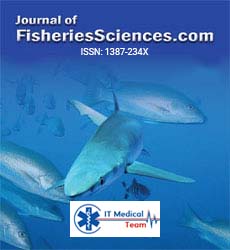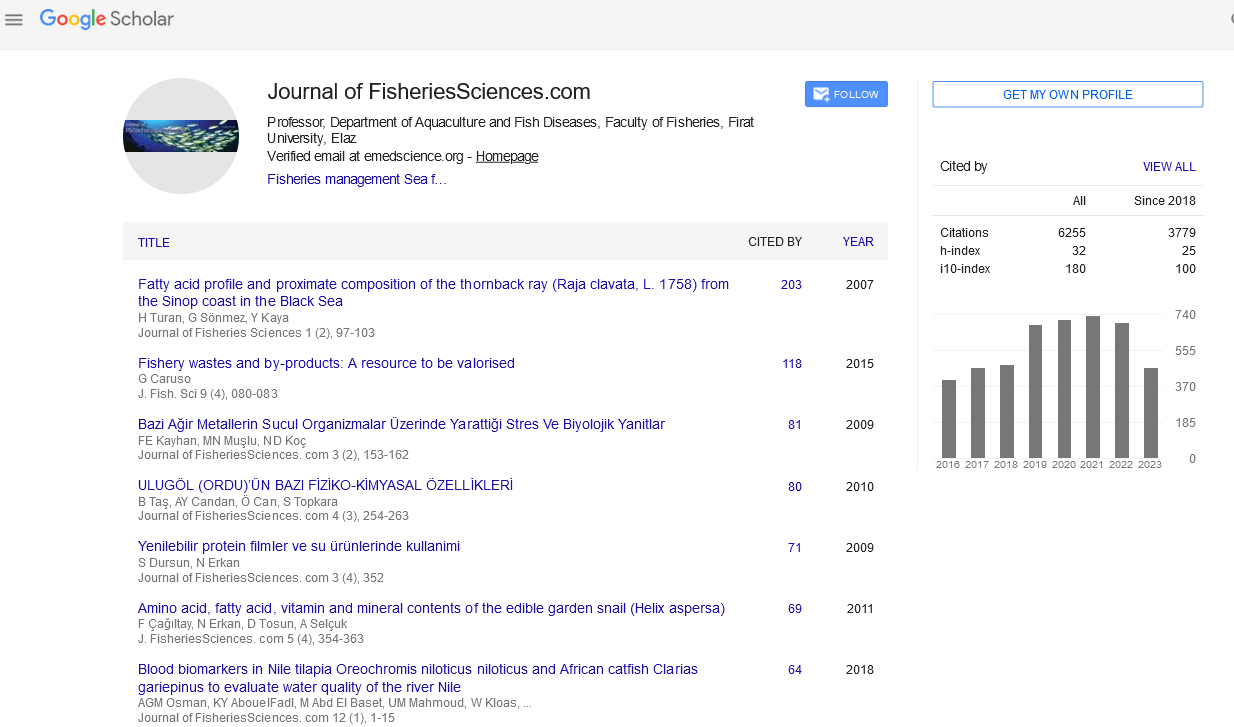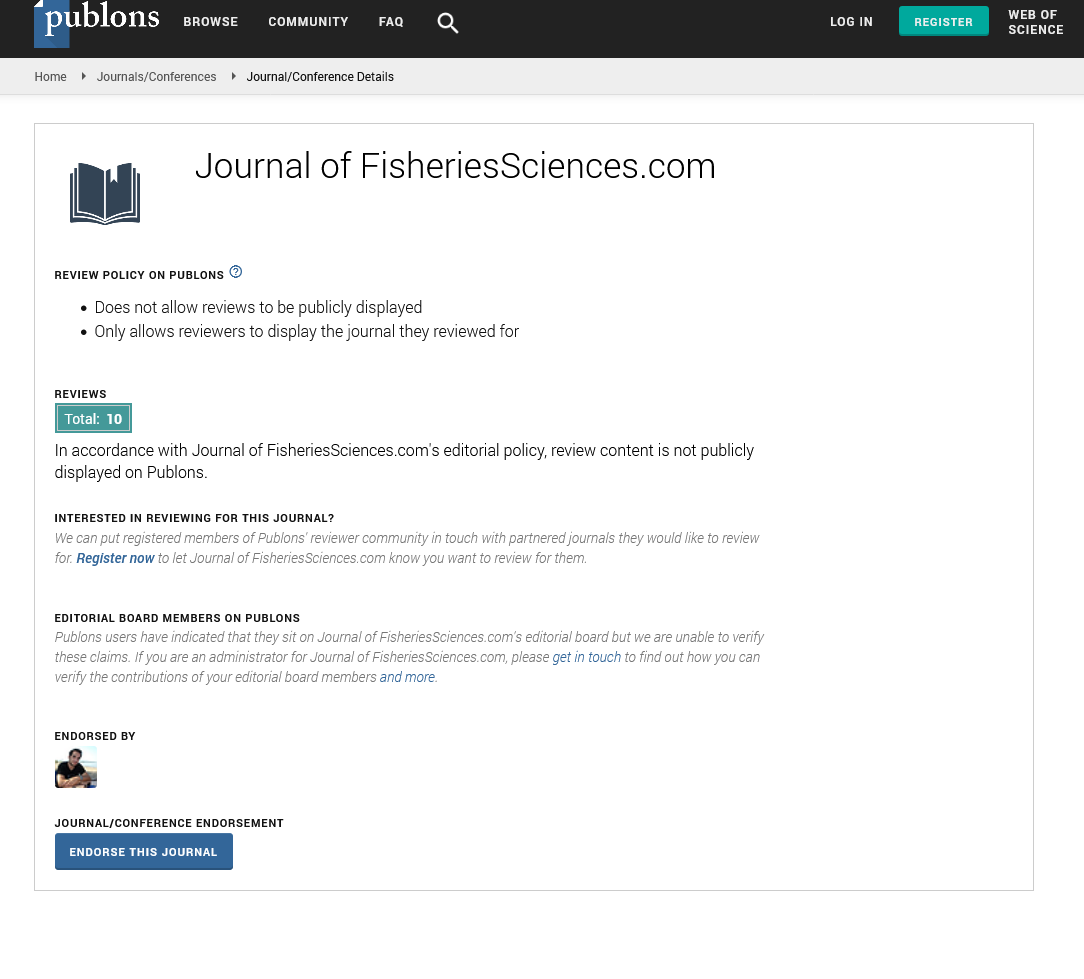Commentary Article - (2023) Volume 27, Issue 1
Salmonids' a Disinfectant with a Capacity of a Fisheries Approach
Lucy Hannah*
Department of Fisheries Science, Faculty of Aquaculture, Fate Well University, Argentina
*Correspondence:
Lucy Hannah, Department of Fisheries Science, Faculty of Aquaculture, Fate Well University,
Argentina,
Email:
Received: 03-Apr-2023, Manuscript No. ipfs-23-13594;
Editor assigned: 05-Apr-2023, Pre QC No. ipfs-23-13594;
Reviewed: 19-Apr-2023, QC No. ipfs-23-13594;
Revised: 21-Apr-2023, Manuscript No. ipfs-23-13594;
Published:
28-Apr-2023
Abstract
Infectious diseases, including those that are bacterial in origin, continue to pose a threat to the aquaculture industry. Aquaculture has displaced capture fisheries as the primary method for producing fish protein, despite the disease burden. The culture of salmonids, which are (a) the most valuable finfish per unit of weight and (b) under unique pressure due to overfishing, is an appealing sector within this industry. Antibiotics are frequently used to combat bacterial disease outbreaks because there are still knowledge gaps regarding fish immunity, which results in vaccines that are not as effective as those for terrestrial species. Even though it works, this method makes it more likely that antibiotic-resistant bacteria will grow. A deeper comprehension of the immune system of teleosts is necessary in order to facilitate the development of vaccines and/or alternative treatments. The state of teleost antibacterial immunity in salmonid aquaculture is highlighted in this review. In addition, the effectiveness of the current approaches to fighting bacterial diseases in salmonid aquaculture will be discussed. In the future, reducing aquaculture losses will be made easier by filling the knowledge gaps in immunology that have been highlighted here.
Keywords
Aquaculture; Salmonids; Bacterial pathogens; Comparative immunology; Adjuvants
Introduction
It was only a matter of time before aquatic environments
became the new frontier for agriculture given that
freshwater and saltwater make up 72% of the Earth's
surface area. It is not surprising that advances in aquatic
animal husbandry have lagged behind those in terrestrial
species because the majority of food animals are raised on
land [1]. It is obvious that aquatic habitats must be utilized
for the production of animal food as a result of the growing
global population and the limited availability of productive
land. In this day and age, when cardiovascular disease is
the leading cause of death worldwide, many aquatic species
provide an alternative protein source that is heart-healthy
due to their high polyunsaturated fatty acid content [2].
Worldwide demand for fish protein is high for all of these
and other reasons. In point of fact, it is at a level so high
that fisheries are unable to satisfy the global demand while
also adhering to the harvesting restrictions that are in place
at the moment [3]. Because it is logistically difficult to
effectively enforce these restrictions, this puts a strain on
wild populations.
Aquaculture, or the cultivation of aquatic species, may
offer a solution to some of the pressure that is placed on
wild populations [4]. This culture production is still in its
infancy for many aquatic species, so it will take time to
comprehend and improve these industrial practices. The
rising incidence of infectious diseases, including those
caused by bacterial pathogens, is one manifestation of
the challenges aquaculture faces [5]. Bacteria are able to
thrive in novel farm environments with high density. As a
consequence of this, a lot of these common microorganisms
become opportunistic pathogens in aquaculture settings
[6]. Getting a more profound comprehension of bacterial
sicknesses that influence hydroponics, as well as what is
a viable safe reaction in important hosts, is significant to
improve this industry. The cultivation of various species of
fish will be referred to as "aquaculture" for the purposes of
this review [7].
Innate immunity of fish
Teleost adaptive immunity has its limitations, such as a
limited antibody repertoire and slow initiation. The innate
immune system bears the majority of the responsibility
for preventing and combating infectious diseases [8]. It
has been demonstrated that fish possess all of the physical
barriers (skin and mucous membranes) and humoral
parameters (complement, natural antibody, toll-like
receptors, etc.) that are typically associated with innate
immunity in mammals and components of cells (such as NK cells and phagocytosis) [9]. The fact that the majority
of the broad-spectrum parameters of innate immunity are
highly conserved across species and taxa as the first line of
defense is not surprising. The innate immune system of
all jawed vertebrates has a rapid defense against invading
pathogens and tissue damage. However, it is unable to
provide long-term immunological memory or well-targeted
protection against individual pathogens [10].
DISCUSSION
Although eukaryotic cell lines are an extremely useful tool
for conducting biological experiments, they should not be
regarded as an alternative to conducting research on whole
animals. In circumstances where in vivo examinations are
unrealistic or there are mechanical constraints, cell lines
can give primer outcomes that is theory creating. However,
it is essential to keep in mind that each cell line represents
a single cell type from a single individual. As a result, these
model systems cannot be expected to accurately represent
entire animals or processes, such as immune responses,
that require the interactions of multiple cell types. This is
upheld by various examinations wherein mammalian cell
lines have uncovered that section number and culture time
can impact quality articulation, protein movement, and
morphology and cell reactivity/responsiveness. Although
little research has been done to document this disconnect
in teleost cell lines, it is certain to have similar limitations.
CONCLUSION
The vertebrate immune system is a complex system that
works together to protect the body from infectious agents
and other foreign substances. It is made up of molecules with
complementary and antagonistic actions, cells that interact,
and cell-forming tissues. The immune system's complexity
is the result of over 500 million years of evolution, not a
single event. The immune system has continuously evolved
between taxa throughout this time, preserving valuable
components and eliminating useless ones. Because aquatic
and terrestrial organisms live in such distinct habitats, they
are subject to distinct evolutionary pressures. As a result,
environmental differences are reflected in species-specific
differences in immune system composition. As a result, it
should come as no surprise that we have been able to use
comparative models to (a) improve our comprehension of
immunity in mammals, (b) enhance species-specific animal
husbandry, and (c) discover useful immunological tools for
applications in molecular biology. This review attempted
to list some of the most recent findings regarding teleost
antibacterial immunity.
References
- Hendrickson, Dean A, Krejca Jean K, et al. Mexican blindcats genus Prietella (Siluriformes: Ictaluridae): an overview of recent explorations. Environmental Biology of Fishes. 2001; 62: 315-337.
Google Scholar, Crossref, Indexed at
- Nico Leo G, Martin R, Trent. The South American Suckermouth Armored Catfish, Pterygoplichthys anisitsi (Pisces: Loricaridae), in Texas, with Comments on Foreign Fish Introductions in the American Southwest. Southwest Nat. 2001; 46: 98-104.
Google Scholar, Crossref, Indexed at
- Wakida-Kusunokia Armando T, Ruiz-Carusb Ramon, Amador-del-Angelc Enrique. Amazon Sailfin Catfish, Pterygoplichthys pardalis (Castelnau, 1855) (Loricariidae), Another Exotic Species Established in Southeastern Mexico. Southwest Nat. 2007; 52: 141-144.
Google Scholar, Crossref, Indexed at
- Chavez Joel M, de la Paz Reynaldo M, Manohar Surya Krishna, et al. New Philippine record of South American sailfin catfishes (Pisces: Loricariidae) (PDF). Zootaxa. 2007; 1109: 57-68.
Google Scholar, Crossref, Indexed at
- Nico Leo G, Martin R, Trent. The South American Suckermouth Armored Catfish, Pterygoplichthys anisitsi (Pisces: Loricaridae), in Texas, with Comments on Foreign Fish Introductions in the American Southwest. Southwest Nat. 2001; 46: 98-104.
Google Scholar, Crossref, Indexed at
- Wakida-Kusunokia, Armando T, Ruiz-Carusb Ramon. Amazon Sailfin Catfish, Pterygoplichthys pardalis (Castelnau, 1855) (Loricariidae), Another Exotic Species Established in Southeastern Mexico. The Southwestern Naturalist. 2007; 52: 141-144.
Google Scholar, Crossref, Indexed at
- Friel J P, Lundberg J G. Micromyzon akamai, gen ET sp Nov, a small and eyeless banjo catfish (Siluriformes: Aspredinidae) from the river channels of the lower Amazon basin. Copeia. 1996: 641-648.
Google Scholar, Crossref
- Ballen Gustavo A, De Pinna Mario C. A standardized terminology of spines in the order Siluriformes (Actinopterygii: Ostariophysi). Zool J Linn Soc. 2022; 194: 601-625.
Google Scholar, Crossref, Indexed at
- Ferreira JG, Hawkins AJS, Bricker SB. Management of productivity, environmental effects and profitability of shellfish aquaculture-The Farm Aquaculture Resource Management (FARM) model (PDF). Aquaculture. 2007; 264: 160-174.
Google Scholar, Crossref, Indexed at
- Corpron KE, Armstrong DA. Removal of nitrogen by an aquatic plant, Elodea densa, in recirculating Macrobrachium culture systems. Aquaculture. 1983; 32: 347-360.
Google Scholar, Crossref






